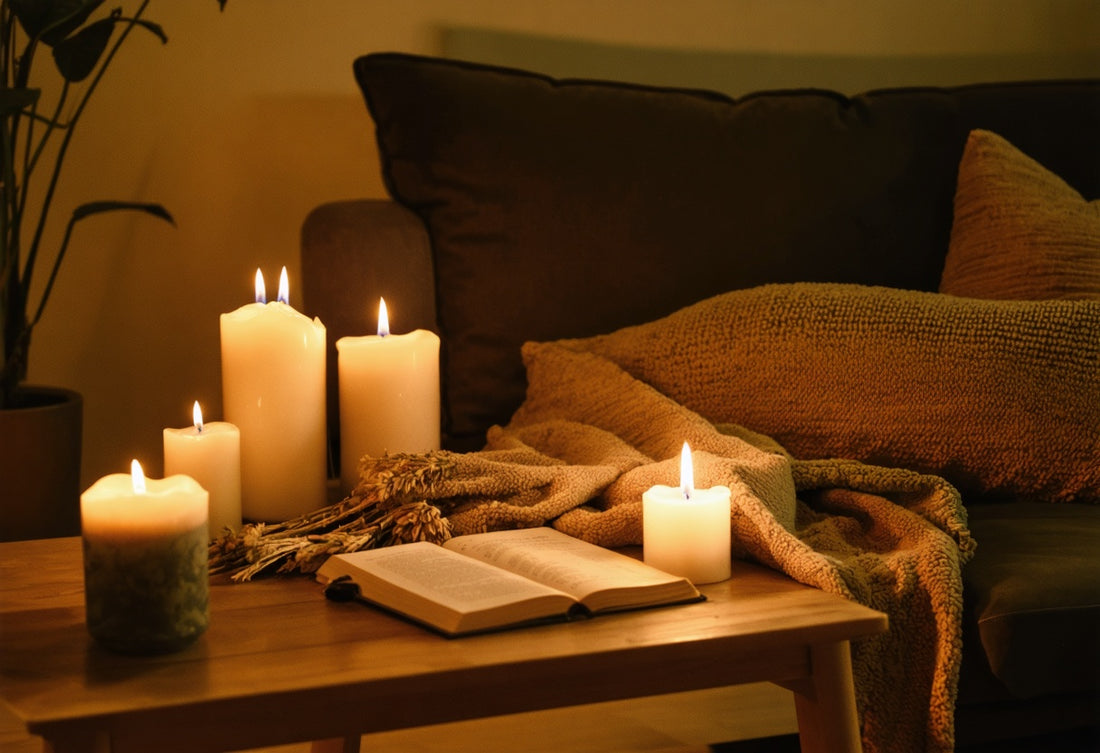
How to Use Candles for Relaxation: 5 Proven Techniques for Stress Relief
Share
Creating a Candle Meditation Space
The practice of using candles as a form of relaxation has deep historical roots across many cultures. Today, this simple yet powerful tool continues to offer a gateway to tranquility in our busy lives. Creating a dedicated space for candle meditation can transform an ordinary moment into a profound relaxation experience. The gentle, consistent flame provides a focal point that naturally draws your attention away from racing thoughts and into the present moment.
Selecting the Right Candles for Relaxation
Not all candles create the same relaxation experience. When choosing candles specifically for meditation and stress relief, consider these important factors:
Flame stability: Look for candles with minimal flickering to maintain focus without distraction. Soy and beeswax candles typically burn more steadily than paraffin options.
Scent profile: Unscented candles work best for pure meditation practices where the visual element is primary. However, if you're incorporating aromatherapy, select natural essential oil-infused candles rather than synthetic fragrances, which can contain chemicals that disrupt your relaxation.
Size and burn time: Taper candles create elegant, tall flames ideal for focused gazing, while wider pillar candles offer stability and longer burn times for extended sessions.
Container type: Clear glass containers allow you to observe the full flame, while colored glass creates ambient lighting effects that can enhance your relaxation environment.
Setting Up Your Peaceful Environment
The space where you practice candle meditation significantly impacts your relaxation experience. Consider these elements when creating your sanctuary:
Location selection: Choose a quiet corner away from drafts that might disturb the flame. Ensure the space has minimal distractions and feels separate from your everyday activities.
Comfortable seating: Position yourself at eye level with the candle flame, using cushions, a meditation bench, or a comfortable chair that supports good posture without strain.
Safety considerations: Always place candles on stable, heat-resistant surfaces and keep flammable materials at a safe distance. Never leave burning candles unattended, and consider using battery-operated flameless candles if safety is a concern.
Minimal décor: Keep the space simple and uncluttered to minimize visual distractions. A few meaningful objects that promote calm can enhance the space without overwhelming it.
Breathwork Techniques with Candle Gazing
Combining intentional breathing with candle gazing creates a powerful relaxation synergy. This practice, known as Trataka in yogic traditions, helps calm the mind while improving concentration and mental clarity.
The 4-7-8 Breathing Method
This structured breathing technique, developed by Dr. Andrew Weil, becomes even more effective when paired with candle gazing:
Position your candle at eye level about arm's length away.
Focus your gaze softly on the flame.
Inhale quietly through your nose for a count of 4.
Hold your breath for a count of 7, maintaining gentle focus on the flame.
Exhale completely through your mouth for a count of 8, making a whooshing sound.
Repeat this cycle 3-4 times initially, gradually increasing to 8 repetitions.
Research from the National Center for Complementary and Integrative Health suggests that controlled breathing techniques like this one can activate your parasympathetic nervous system, reducing stress hormones and promoting relaxation.
Mindful Observation Practice
This technique cultivates present-moment awareness through detailed observation:
Sit comfortably with your candle positioned safely in front of you.
Allow your eyes to rest gently on the flame without straining.
Notice the flame's shape, colors, movement, and how the wax slowly transforms.
When your mind wanders (which is natural), gently return your attention to observing the flame.
Practice for 5-10 minutes, gradually extending the duration as your concentration improves.
According to research published in the Journal of Psychophysiology, this type of focused attention meditation can significantly reduce stress markers and improve emotional regulation.
Aromatherapy Candles for Stress Relief
Aromatherapy candles combine the visual relaxation benefits of candlelight with the psychological and physiological effects of essential oils. When selecting aromatherapy candles for stress relief, look for these evidence-backed scents:
Lavender: Research published in the Journal of Alternative and Complementary Medicine confirms lavender's effectiveness in reducing anxiety and promoting sleep quality.
Bergamot: This citrus scent has been shown to reduce cortisol levels and improve positive mood, according to studies in the journal Phytotherapy Research.
Vanilla: Often associated with comfort and warmth, vanilla has been shown to reduce startle responses and promote feelings of relaxation.
Sandalwood: This earthy scent has been used in meditation practices for centuries and has demonstrated anxiety-reducing properties in clinical studies.
For the most effective aromatherapy experience, choose 100% natural soy or beeswax candles infused with pure essential oils rather than synthetic fragrances.
Timing Your Aromatherapy Sessions
The effectiveness of aromatherapy candles depends partly on when and how you use them:
Optimal duration: Light your aromatherapy candle 15-20 minutes before beginning your relaxation practice to allow the scent to permeate the space.
Room size considerations: In larger rooms, consider using multiple candles of the same scent to achieve sufficient aromatic intensity.
Scent rotation: To prevent sensory adaptation (when you stop noticing a familiar scent), rotate between 2-3 different relaxation-promoting scents throughout the week.
Time of day: Morning sessions might benefit from energizing scents like rosemary or mint, while evening relaxation calls for calming scents like lavender or chamomile.
Incorporating Candles into Your Wellness Routine
Using candles as a form of relaxation becomes most effective when integrated into a consistent wellness practice. Rather than an occasional indulgence, consider making candlelight a regular feature in your self-care routine.
Evening Wind-Down Rituals
Creating a candle-centered evening ritual signals to your body and mind that it's time to transition from daytime activity to restful sleep:
Digital sunset: Light a candle as you turn off electronic devices, allowing the natural light to replace blue-light exposure.
Journaling by candlelight: The soft illumination creates an introspective atmosphere perfect for reflection and gratitude practices.
Reading ritual: Replace harsh reading lights with strategic candle placement for a more relaxing literary experience.
Tea ceremony: Pair your candle meditation with a cup of caffeine-free herbal tea, creating a multi-sensory relaxation experience.
Research from the Sleep Foundation indicates that consistent bedtime rituals significantly improve sleep quality and reduce the time needed to fall asleep.
Weekend Relaxation Practices
Weekends offer opportunities for extended candle-based relaxation practices:
Morning intention setting: Begin your weekend with a 10-minute candle meditation to set positive intentions for your days off.
Midday reset: When weekend obligations feel overwhelming, take a short candle-gazing break to recenter yourself.
Social connection: Share the relaxation experience by incorporating candles into gatherings with friends or family meals.
Creativity sessions: The gentle illumination of candles can enhance creative thinking and artistic expression during weekend hobby time.
Enhancing Other Relaxation Practices with Candles
Candles can amplify the effectiveness of various relaxation techniques, creating multi-dimensional experiences that engage multiple senses simultaneously.
Candle-Lit Baths
Transform an ordinary bath into a therapeutic experience by incorporating candles:
Placement strategy: Position candles at different heights around your bathroom (ensuring safety) to create a spa-like atmosphere with layered lighting.
Water temperature: Research suggests that a warm bath (around 104°F) combined with relaxation techniques like candle meditation optimizes both physical and mental relaxation.
Duration optimization: A 20-30 minute candle-lit bath provides sufficient time for both physical tension release and mental unwinding.
Enhanced mindfulness: The combination of warm water, gentle lighting, and perhaps aromatherapy creates an ideal environment for practicing body scan meditation or gratitude reflection.
For safety, always place candles where they cannot be knocked over and where water splashes won't reach them.
Yoga and Stretching by Candlelight
Gentle movement practices take on new dimensions when performed by candlelight:
Visual focus: In balance poses, a candle flame can serve as a drishti (focal point) to enhance stability and concentration.
Rhythm alignment: Synchronize your breath and movements with the steady, calm nature of the flame.
Space transformation: Even familiar practice spaces feel renewed and special when illuminated by candles rather than artificial lighting.
Deepened relaxation: Candlelight naturally signals to your nervous system that it's time to slow down, potentially deepening the relaxation benefits of your final savasana or meditation.
Many yoga studios now offer special candlelight classes, recognizing the enhanced relaxation benefits this simple change provides to practitioners.
Making Candles a Cornerstone of Your Relaxation Practice
Using candles as a form of relaxation offers a simple yet profound way to transform everyday moments into opportunities for stress relief and mindfulness. The gentle, primal nature of firelight connects us to centuries of human experience while providing practical benefits for our modern, overstimulated minds.
By incorporating candle practices into your regular routine, you create consistent touchpoints for relaxation throughout your week. Whether you're drawn to the meditative aspects of candle gazing, the aromatic benefits of essential oil candles, or simply the aesthetic pleasure of soft, flickering light, candles offer an accessible entry point to deeper relaxation.
Remember that consistency matters more than duration. Even five minutes of intentional candle meditation can reset your nervous system and improve your stress resilience. Experiment with different techniques described in this guide to discover which resonates most with your needs and preferences. Over time, the mere sight of your meditation candle may become a powerful relaxation trigger, helping you transition more quickly into a state of calm awareness.
